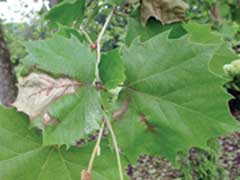Sycamore Anthracnose is another tree disease that’s common here in the Kansas City area. This is a tree disease that attacks sycamore trees. The disease is caused by a fungus called Apiognomia veneta, which typically flourishes during cool, wet spring weather, according to the Missouri Department of Conservation.
Trees that have been affected by sycamore anthracnose will usually have brown lesions develop along the leaf veins, which can deform the affected leaves, as well as twig dieback, wilting, and the browning of newly emerging leaves. These brown, wilted leaves will drop as sycamore anthracnose progresses and it can happen very suddenly.
This tree disease doesn’t usually cause fatal damage. In fact, sycamore trees usually re-flush new leaves as a response to the defoliation caused by sycamore anthracnose, the Missouri Department of Conservation reports. A normal appearance usually returns to affected trees by early July. However, repeated defoliation during the same season can cause stress to the tree, causing other damaging agents to arise.
Cartwright Tree Care offers a preventative treatment for sycamore anthracnose, which lasts up to three years and works as both a preventative treatment and a control measure. If you have sycamore trees on your property, contact us today to learn more about this treatment.
Photo credit: Imp.msu.edu via Google Image Search

